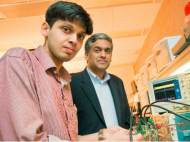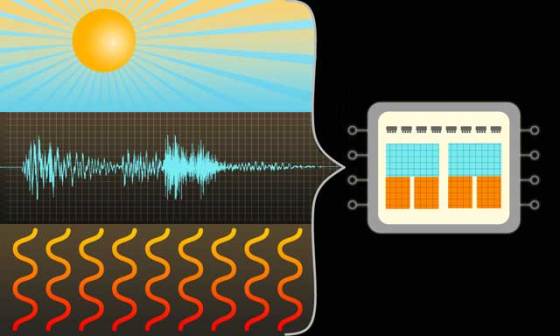New chip harnessing power from light, heat and vibrations
 Most efforts to harness multiple energy sources so far have employed switching to the source which provides most energy at that moment, but a group of researchers at MIT developed a system able to combine energy from multiple sources by switching rapidly between them. The system could to be used in new battery-free monitoring systems which are suitable for use in biomedical devices, environmental sensors in remote locations and gauges in hard-to-reach spots.
Most efforts to harness multiple energy sources so far have employed switching to the source which provides most energy at that moment, but a group of researchers at MIT developed a system able to combine energy from multiple sources by switching rapidly between them. The system could to be used in new battery-free monitoring systems which are suitable for use in biomedical devices, environmental sensors in remote locations and gauges in hard-to-reach spots.
Led by Anantha Chandrakasan, the Keithley Professor of Electrical Engineering and head of MIT’s Department of Electrical Engineering and Computer Science, the group developed a chip that can harness energy form natural light, heat and vibrations. Combining the power from these variable sources requires a sophisticated control system with small power consumption, and that was one of the challenges researchers had to work out.
The system consists of a reconfigurable multi-input, multi-output switch matrix that combines energy from photovoltaic, thermoelectric, and piezoelectric energy-harvesting sources. The chip uses a single time-shared inductor (coil) which works with multiple converters, rather than using separate ones for each source.
The innovative dual-path architecture of the system allows the sensor to be powered either from a storage device or directly from the source, bypassing the storage systems such as batteries or supercapacitors altogether. This architecture for energy harvesting provides a peak efficiency improvement of 11% to 13% over the traditional two-stage approach.
According to information published in their research paper, the proposed time-based power monitor is used for achieving maximum power point tracking for the photovoltaic harvester with peak tracking efficiency of 96%. The peak efficiencies of energy converters achieved with inductor sharing are 83% for photovoltaic boost, 58% for thermoelectric boost, and 79% for piezoelectric buck-boost converters.
“The work being done at MIT is very important to enabling energy harvesting in various environments. The ability to extract energy from multiple different sources helps maximize the power for more functionality from systems like wireless sensor nodes”, said David Freeman, chief technologist for power-supply solutions at Texas Instruments, who was not involved in this work. “The benefits from operating from multiple sources not only include maximizing peak energy, but also help when only one source of energy may be available.”
For more information, read the paper published in the IEEE Journal of Solid-State Circuits: “Platform Architecture for Solar, Thermal, and Vibration Energy Combining With MPPT and Single Inductor”.










Leave your response!